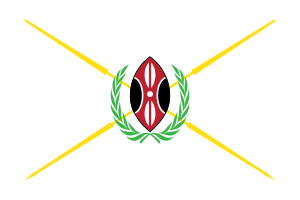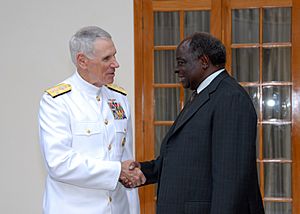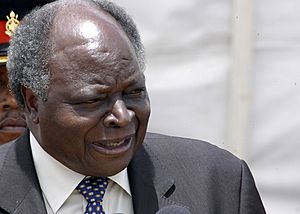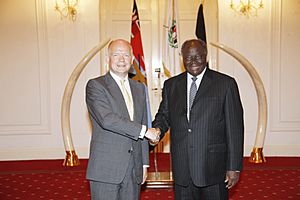Mwai Kibaki facts for kids
Quick facts for kids
Mwai Kibaki
CGH
|
|
|---|---|
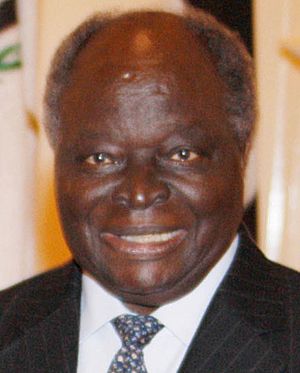
Kibaki in 2011
|
|
| 3rd President of Kenya | |
| In office 30 December 2002 – 9 April 2013 |
|
| Prime Minister | Raila Odinga (2008–2013) |
| Vice President | Michael Wamalwa Moody Awori Kalonzo Musyoka |
| Preceded by | Daniel Arap Moi |
| Succeeded by | Uhuru Kenyatta |
| 4th Vice President of Kenya | |
| In office 14 October 1978 – 24 March 1988 |
|
| President | Daniel Arap Moi |
| Preceded by | Daniel Arap Moi |
| Succeeded by | Josephat Karanja |
| 5th Minister for Health | |
| In office 1988–1991 |
|
| President | Daniel Arap Moi |
| Preceded by | Samuel Ole Tipis |
| Succeeded by | Joshua Mulanda Angatia |
| 2nd Minister for Finance (Kenya) | |
| In office 1969–1982 |
|
| President | Daniel Arap Moi Jomo Kenyatta |
| Preceded by | James Gichuru |
| Succeeded by | Arthur Magugu |
| 3rd Member of Parliament | |
| In office 1974 – 28 March 2013 |
|
| Preceded by | King'ori Muhiukia |
| Succeeded by | Mary Wambui |
| Constituency | Othaya |
| Member of Parliament | |
| In office 1963–1974 |
|
| Preceded by | Post established |
| Succeeded by | James Muriuki |
| Constituency | Doonholm |
| Personal details | |
| Born |
Emilio Stanley Mwai Kibaki
15 November 1931 Gatuyaini, British Kenya |
| Died | 21 April 2022 (aged 90) Nairobi, Kenya |
| Resting place | Minister for Finance |
| Political party | Kenya African National Union (1963–1992) Democratic Party (1992–2007) Party of National Unity (2007–2013) |
| Spouse | |
| Children | 4 |
| Parent |
|
| Education | University of East Africa, Makerere College, Kampala.(BA in Economics, History and Political Science) London School of Economics (BSc in Public Finance) |
| Signature | |
Emilio Mwai Kibaki (born November 15, 1931 – died April 21, 2022) was an important Kenyan politician. He served as the third President of Kenya from December 2002 to April 2013.
Before becoming president, he was the fourth Vice-President of Kenya for ten years (1978–1988) under President Daniel arap Moi. He also held several government minister jobs. These included Minister for Finance (1969–1981) and Minister for Health (1988–1991).
Kibaki was also a Member of Parliament for the Official Opposition from 1992 to 2002. He tried to become president in 1992 and 1997 but didn't win. In 2002, he was elected President of Kenya.
Contents
- Early Life and Education
- Political Career Before Presidency
- Presidency
- Becoming President of Kenya
- Kibaki's Leadership Style
- Health During First Term
- Free Primary Education in 2003
- Constitutional Referendum and Government Changes
- The 2007 Elections
- National Accord and Coalition Government in 2008
- Economic Achievements: A Turnaround
- Constituency Development Fund and Vision 2030
- Political Legacy and Challenges
- The 2010 Constitution
- Handover of Power in 2013
- Personal Life
- Death and State Funeral
- Honours and Awards
- Images for kids
- See also
Early Life and Education
Where was Mwai Kibaki Born?
Mwai Kibaki was born on November 15, 1931. His birthplace was Gatuyaini village in what is now Nyeri County, Kenya. His parents, Kibaki Gĩthĩnji and Teresia Wanjikũ, were farmers. He was given the name Emilio Stanley by missionaries, but he was always known as Mwai Kibaki.
Mwai Kibaki's Schooling Journey
Kibaki started school in his village. He then went to Karima mission school and later to Mathari School (now Nyeri High School) from 1944 to 1946. At Mathari, he learned carpentry and masonry along with his studies. After primary school, he attended Mang'u High School from 1947 to 1950. He achieved the highest grades in his O Level exams there.
University Studies and Early Career
Kibaki thought about joining the army, but a rule prevented people from his community from joining. So, he went to Makerere University in Kampala, Uganda. He studied economics, history, and political science, graduating with top honors in economics.
After Makerere, Kibaki worked for the Shell Company of East Africa. He then won a scholarship to study in Britain. He chose the London School of Economics and earned a degree in public finance. In 1958, he returned to Makerere University to teach economics until 1961. In 1961, Kibaki married Lucy Muthoni, who was a school head teacher.
Political Career Before Presidency
Joining Politics in the 1960s
In 1960, Mwai Kibaki left his teaching job to join politics. He became an executive officer for the Kenya African National Union (KANU) party. He also helped write Kenya's independence constitution.
In 1963, Kibaki was elected as a Member of Parliament for the Doonholm Constituency in Nairobi. This marked the beginning of his long political journey. He was appointed Assistant Minister of Finance in 1963 and later Minister of Commerce and Industry in 1966. From 1969 to 1982, he served as Minister of Finance and Economic Planning.
Moving to Othaya and Vice Presidency
In 1974, Kibaki moved his political base from Nairobi to his home area, Othaya. He was elected as Member of Parliament for Othaya and continued to win re-election there until 2007.
When Daniel arap Moi became President in 1978, Kibaki was made Vice-President of Kenya. He also kept his role as Finance Minister until 1982. Many people consider him one of Kenya's most effective finance ministers. Later, as President, he continued to guide economic policies, leading to strong growth.
Changes in Government Roles
In 1988, Kibaki's relationship with President Moi changed. He was no longer Vice President and was moved to the Ministry of Health. During these years, Kibaki was known for his calm and non-confrontational political style.
From KANU to Opposition Leader
In December 1991, Kenya changed to a multi-party system. To everyone's surprise, Kibaki resigned from the government and left the ruling KANU party. He then started his own party, the Democratic Party (DP).
Kibaki ran for president in 1992 and came in third. He ran again in 1997 and came in second. Both times, the opposition was divided, allowing President Moi to win. Kibaki then became the Leader of the Official Opposition in Parliament from 1998 to 2002.
The 2002 Presidential Election
For the 2002 elections, Kibaki's Democratic Party joined with other opposition parties to form the National Alliance of Rainbow Coalition (NARC). On October 14, 2002, Kibaki was chosen as the NARC presidential candidate.
On December 3, 2002, Kibaki was injured in a car accident while campaigning. He was hospitalized in Nairobi and then London. His injuries meant he had to use a wheelchair for months. His NARC colleagues, led by Raila Odinga, continued his campaign.
On December 27, 2002, Kibaki and NARC won the election by a large margin. Kibaki received 62% of the votes, while the KANU candidate, Uhuru Kenyatta, received 31%.
Presidency
Becoming President of Kenya
On December 30, 2002, Mwai Kibaki was sworn in as the third President of Kenya. He was still recovering from his accident and was in a wheelchair. Thousands of cheering supporters gathered at Uhuru Park in Nairobi to witness the historic moment.
Kibaki's swearing-in ended four decades of rule by the KANU party. President Moi, who had been in power for 24 years, retired.
Kibaki's Leadership Style
President Kibaki was known for being a quiet but very smart and capable leader. He did not try to create a "personality cult" like some leaders. He didn't have his picture on all currency or have many places named after him. He also didn't dominate news reports with his daily activities.
His leadership style made him seem like a thoughtful expert. He often delegated tasks, meaning he trusted others to handle government affairs.
Health During First Term
Many people believe that Kibaki's age and the 2002 accident affected his performance during his first term. He had to read speeches, unlike before when he could speak for a long time without notes. In January 2003, he was hospitalized for a blood clot from his accident. His health issues during this time meant that close aides helped manage government affairs.
Free Primary Education in 2003
In January 2003, President Kibaki started a program for free primary education. This allowed over 1 million children who couldn't afford school to attend. This initiative was praised by many, including Bill Clinton.
Constitutional Referendum and Government Changes
In 2005, a vote was held on a new constitution. The main debate was about how much power the president should have. Kibaki supported the proposed constitution, but some of his own cabinet members, led by Raila Odinga, opposed it. They joined with the opposition party KANU. The proposal was rejected by 58% of voters.
After this loss, Kibaki dismissed his entire cabinet in November 2005. He wanted to remove ministers who had opposed him. He then appointed a new cabinet, including some members from the opposition, forming a "Government of National Unity."
The 2007 Elections
On January 26, 2007, President Kibaki announced he would run for re-election. He formed a new alliance called the Party of National Unity. His main opponent was Raila Odinga, who led the Orange Democratic Movement (ODM).
Polls before the election showed a close race between Kibaki and Odinga. Kibaki was popular in his home regions, while Odinga had support in other parts of the country.
National Accord and Coalition Government in 2008
The 2007 election results were disputed, leading to violence across the country. Kofi Annan, the former Secretary-General of the United Nations, helped mediate a peace deal.
In February 2008, Kibaki and Odinga signed an agreement called the "national accord." This deal created a power-sharing government. Kibaki remained President, and Raila Odinga became the new Prime Minister of Kenya.
On April 17, 2008, Odinga was sworn in as Prime Minister. A large cabinet was formed, with ministers appointed by both Kibaki and Odinga. This arrangement was known as the "Grand Coalition Government."
Economic Achievements: A Turnaround
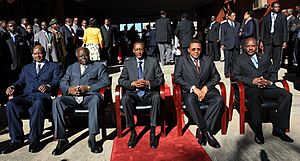
President Kibaki, an economist, aimed to improve Kenya's economy after years of challenges under the previous government. Kenya's economy saw a major turnaround during his presidency. The country's economic growth increased significantly.
Development projects started in all parts of the country, even in areas that had been neglected. Many state-owned companies that had struggled began to do well again. The telecommunications sector grew rapidly.
Major infrastructure projects, like the Thika Superhighway, were completed. Cities and towns also began to be renewed and modernized.
Constituency Development Fund and Vision 2030
The Constituency Development Fund (CDF) was introduced in 2003. This fund helped support local development projects in every constituency. It aimed to ensure that development resources were shared fairly across all regions. CDF helped build new water, health, and education facilities, especially in remote areas.
President Kibaki also oversaw the creation of Kenya Vision 2030. This is a long-term plan to make Kenya a middle-income country by 2030. It aims to increase economic growth to 10% each year.

During Kibaki's time, Kenya became less dependent on aid from Western countries. The country started to fund more projects using its own tax money. Relations with countries like China, Japan, and other non-Western powers also grew stronger.
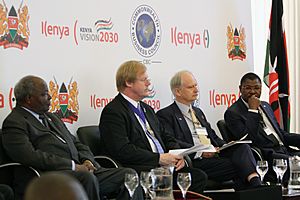
Political Legacy and Challenges
Critics sometimes said that President Kibaki relied on a small group of older advisors, mainly from his own community. This led to a perception that his presidency favored certain groups.
While President Kibaki was not personally accused of corruption, it remained a challenge in Kenya. However, he did manage to stop the widespread grabbing of public land that had been common in earlier years.
The 2010 Constitution
A major achievement of President Kibaki's time was the passing of Kenya's new 2010 Constitution. He strongly supported this new constitution, which aimed to fix many of Kenya's governance issues. This led to wide-ranging reforms in laws and institutions. Kibaki skillfully guided these changes in his final years as president. His son, Jimmy, called the approval of the new Constitution "a very deep and emotional moment for him."
Handover of Power in 2013
On April 9, 2013, Kibaki handed over the presidency to his successor, Uhuru Kenyatta. This happened at a public ceremony at Kenya's largest stadium. Kibaki said he was happy to pass the leadership torch to a new generation. He thanked his family and all Kenyans for their support.
This marked the end of his presidency and 50 years of public service.
Personal Life
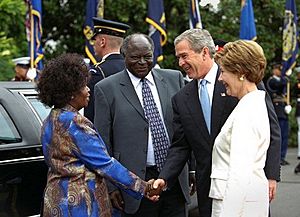
Kibaki was married to Lucy Muthoni from 1961 until her death in 2016. They had four children: Judy Wanjiku, Jimmy Kibaki, David Kagai, and Tony Githinji. They also had several grandchildren.
Kibaki enjoyed playing golf and was a member of the Muthaiga Golf Club. He was a devoted member of the Roman Catholic Church and attended Consolata Shrines Catholic Church every Sunday.
On August 21, 2016, Kibaki was taken to Karen Hospital and later flew to South Africa for special medical treatment. Unlike some other political families, Kibaki's immediate family has not shown much interest in politics.
Death and State Funeral
Mr. Kibaki passed away on April 21, 2022, at the age of 90. President Uhuru Kenyatta announced his death. He declared a period of national mourning and said Kibaki would receive a state funeral with full civilian and military honors. Flags were flown at half-mast until his burial.
On April 25, 2022, Kibaki's body was taken to Parliament buildings on a military gun carriage. This allowed Kenyans, led by President Uhuru Kenyatta, to view his body. His body was laid on a special platform, dressed in his trademark pin-striped suit. It was guarded by four Kenya Defence Forces colonels.
The lying in state continued until April 27, 2022. A funeral service was held at Nyayo National Stadium on April 29, 2022. Many important guests, including sitting presidents, attended. He was buried at his home in Othaya, Nyeri County, on April 30, 2022. The burial included full military honors, such as a 19-gun salute. Countries like South Sudan and Tanzania also declared days of mourning.
Honours and Awards
- Chief of the Order of the Golden Heart of Kenya (C.G.H.)
Honorary Degrees
| University | Country | Honour | Year |
|---|---|---|---|
| University of Nairobi | Doctor of Letters | 2004 | |
| Jomo Kenyatta University of Agriculture and Technology | Doctor of Science | ? | |
| Masinde Muliro University of Science and Technology | Doctor of Science | 2008 | |
| University of Nairobi | Doctor of Laws | 2008 | |
| Kenyatta University | Doctor of Education | 2010 | |
| Makerere University | Doctor of Laws | 2012 | |
| Dedan Kimathi University of Technology | Doctor of Humane Letters | 2013 |
Images for kids
See also
 In Spanish: Mwai Kibaki para niños
In Spanish: Mwai Kibaki para niños


